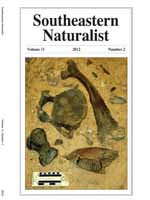Although Mammuthus columbi (Columbian Mammoth) remains have been collected and extensively studied throughout the United States, limited in situ material has been discovered in Georgia. Here we describe new Columbian Mammoth material from Clark Quarry, a recently excavated late-Pleistocene locality near Brunswick, GA, and discuss their historical and paleoecological significance. The site has yielded 12 genera of birds, 18 genera of amphibians and reptiles, and 12 species of mammals. Radiocarbon analyses bracket the locality between 19,840 and 22,240 radiocarbon years before present. In 1857, Falconer designated a partial third upper molar unearthed during the excavation of the Brunswick Altamaha Canal as the type specimen for Mammuthus (Elephas) columbi. Clark Quarry borders the abandoned Brunswick Altamaha Canal, and presents the possibility that this new material could be from the type locality of Mammuthus columbi. Material identified thus far indicates a minimum of two individuals and includes a juvenile palate and lower jaw with cheek teeth, adult tooth fragments, complete and partial adult long-bones, carpals, tarsals, ribs, sternal elements, and cervical, thoracic, and caudal vertebrae.
How to translate text using browser tools
1 June 2012
New Skeletal Remains of Mammuthus columbi from Glynn County, Georgia with Notes on their Historical and Paleoecological Significance
David B. Patterson,
Alfred J. Mead,
Robert A. Bahn
ACCESS THE FULL ARTICLE

Southeastern Naturalist
Vol. 11 • No. 2
June 2012
Vol. 11 • No. 2
June 2012




